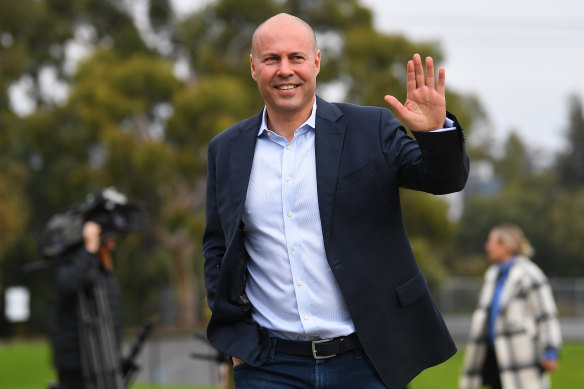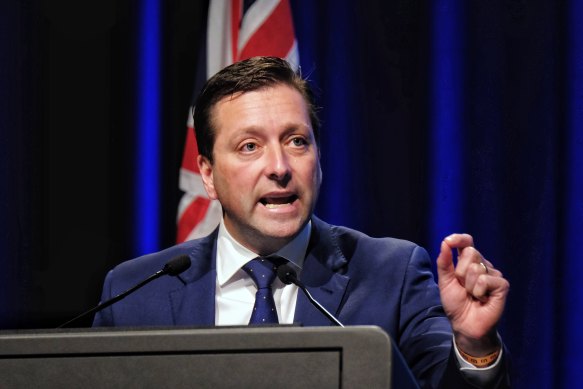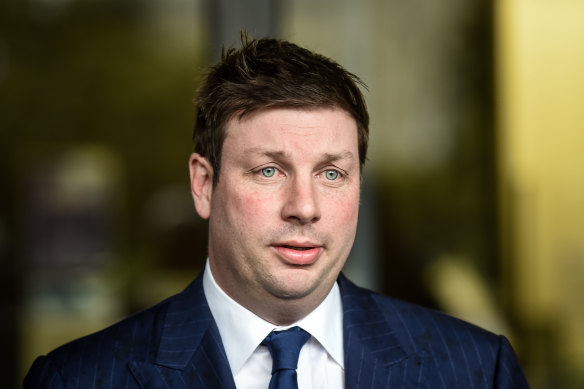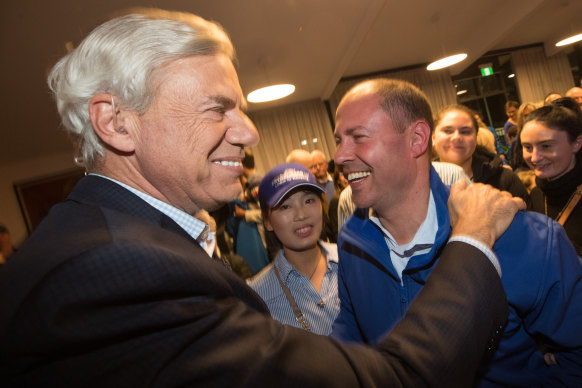- Analysis
- Politics
- Federal
- Australia votes
This was published 2 years ago
Existential battle looms for Victorian Liberals as they digest wipeout
By Josh Gordon
The electoral map of Melbourne is devastating for the Liberal Party.
Australia’s second-largest city is now awash with red representing Labor seats, except for a splash of green in the inner urban seat of Melbourne, and two splodges of teal, one in the adjoining leafy inner-eastern seat of Kooyong, the other in the wealthy bayside electorate of Goldstein.
The only obvious bolt of blue is the outer-eastern seat of Aston, narrowly held by former education minister Alan Tudge after a significant 11.9 per cent slump in his primary vote.
Two other Liberal seats in the east – Deakin and Menzies – are on a knife-edge. On Sunday Labor’s Matt Gregg was just ahead of Liberal incumbent and Assistant Treasurer Michael Sukkar in Deakin, while Liberal candidate Keith Wolahan was barely ahead in Menzies.
The one bright spot for the Victorian Liberal camp came in the seat of La Trobe, where incumbent Jason Wood increased his margin. The eastern electorate is considered to be beyond Melbourne’s urban fringe.
The broad view from strategists on both sides is that a federal Liberal Maginot line to the east has been breached. The big urban wedge of blue spreading out from the centre of Melbourne to the east that existed before the election has all but been wiped off the map, by teals and Labor between them.
Monash University political scientist Professor Paul Strangio said the Liberal Party had been “hollowed out” in Melbourne, a city that was once its heartland and a core foundation of the post-war ascendancy. La Trobe is now its only safe seat in the state.
“Its representation is potentially as low as five out of 39 seats,” Strangio told The Age. “Much was made of Labor’s abysmal showing in Queensland in 2019, but this is proportionally worse.”
It’s a psephological upheaval a long time in the making. The Liberals have been underperforming in Victoria for four decades. Since 1980, the party of Menzies has lost the two-party preferred vote in the state in 14 out of 16 elections.
Strangio says there has been an apparent lack of determination to address the problem, organisationally or philosophically. A conscious strategy dating back to John Howard saw the Liberal party trade away its progressive credentials and refashion itself into a more conservative, populist party chasing votes in the outer suburbs and regions, particularly among men.

Josh Frydenberg says farewell.Credit: AAP
“Scott Morrison took this strategy to new heights,” Strangio said. “The party’s stance on climate change has vividly illustrated this strategy.
“It was a strategy that was either complacent about its progressive constituencies or, worse under Morrison, seemed to deliberately treat them as expendable. Victoria and particularly Melbourne in this thinking was a place that was simply unamenable to (the new) Liberal values: the Massachusetts of Australia.”
The party is now discussing these issues seriously. The problem is, there are now very few senior Victorian Liberals left to contest the ideological debate.
Treasurer Josh Frydenberg, a man often touted as a future prime minister, has very likely lost his seat of Kooyong to teal independent Monique Ryan.
The Party has also lost Higgins, the seat previously held by former Treasurer Peter Costello, with incumbent Katie Allen trailing Labor 44.6 per cent in two-party-preferred terms. Tim Wilson has lost the seat of Goldstein to a teal, Zoe Daniel.

Victorian Opposition Leader Matthew Guy now faces a tough battle heading into the November 26 state election.Credit: Luis Ascui
State Opposition Leader Matthew Guy must now try to distance the state party from the federal carnage, telling The Age, “Of course there are lessons for the Liberal Party from this result.”
“Victorians have voted for change. They want to be listened to. They want real solutions to challenges we are facing. They want public administration to be about them, and not party politics.”
Tim Smith, the state MP for the seat of Kew until November, described Frydenberg’s loss of Kooyong (which overlaps his state seat) “as an absolute tragedy for the Liberal Party” and the result showed that the Liberal Party “stood for very little in Victoria”.
“That is not a reflection of left or right,” he said. “We didn’t really give anyone enough of a reason to vote for us. You have to have a vision.”
“For 121 years we have held the seat,” Smith told The Age. “We have held the seat of Kew for 95 years. The honest answer is: I can’t believe I’m the last lower house Liberal MP representing a part of Kooyong for the next five months.”

Kew MP Tim Smith.Credit: Justin McManus
Former Victorian Liberal president Michael Kroger echoes the argument.
“At its best the Liberal Party has bold agendas based on its traditional values and compelling arguments for their implementation,” he said, but “Overwhelmingly, a nine-year-old government didn’t convince enough Victorians it had a compelling argument for another three years”. This had led to “disillusionment among voters,” he told The Age.
Kroger says the party needs to tailor its arguments around living standards and the future of the working middle class. But he isn’t necessarily sold on the idea that it should adopt a much more aggressive stance on climate change, beyond examining nuclear power to meet Australia’s energy needs.
Privately some Liberals are more scathing of the Morrison government’s performance, warning it has underscored the size of the task ahead for Guy as he heads towards the November 26 state election.

Federal Treasurer Josh Frydenberg with party powerbroker Michael Kroger.Credit: Jason South
Among many there is a palpable sense of anger over what many see as Sydney-centric approach taken by Morrison, that was often at odds with Victorian’s own brand of liberalism.
Said one senior Victorian Liberal figure, who did not wish to comment on the record, the federal Liberal party was “severely on the nose” in Victoria, having largely overlooked more progressive voters concerned about the environment, integrity, the treatment of women, among other issues.
“The big swings are testament to that. And I think we’ve come off the boil on multiculturalism, off the boil on diversity, and all sorts of other issues like that.
“We were seen to ignore people with needs.”
The Morning Edition newsletter is our guide to the day’s most important and interesting stories, analysis and insights. Sign up here.